When You Wish Upon a (Neglected) Star…
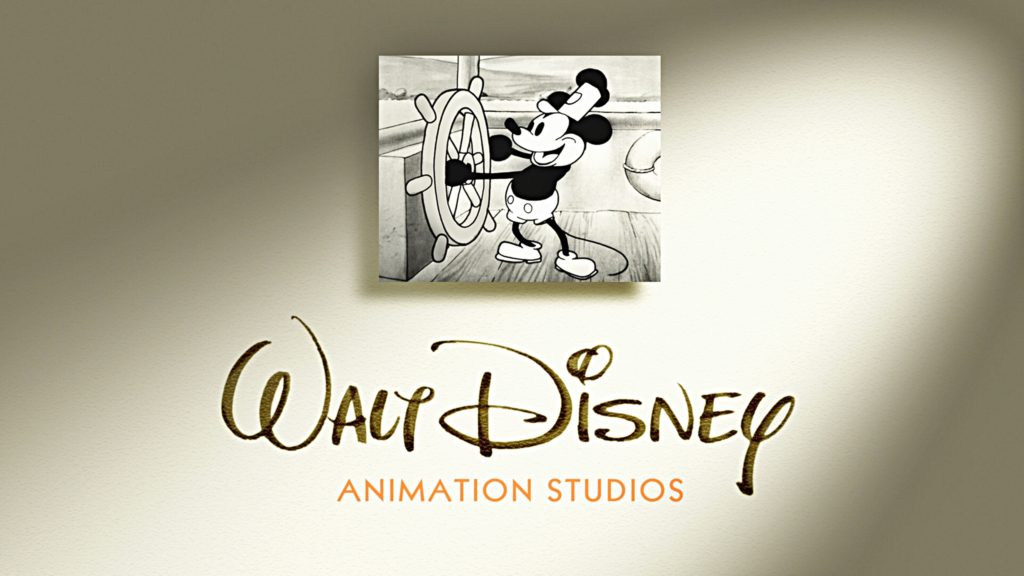
An exercise in futility for cinephiles the world over is recalling the first movie you, the obsessive movie fan, ever saw. Do you count the first movie movie – like one officially seen in a movie theater – or do you include those watched on TV? Indeed, how does memory play into this: just because you, the inveterate movie-watcher, have no remembrance of being dragged as a screaming month-old infant to the June 1977, local opening of a certain science fiction/fantasy epic, does this mean that simply having been there “counts”?
Though I’d be hard-pressed to imagine how my infant self reacted to the visual and aural overload of Star Wars (“not well”, I’d presume), I do vividly recall my reaction three-and-a-half years later to a kiddie matinee showing – at Madison, WI’s Barrymore Theatre – of Walt Disney’s Snow White and the Seven Dwarfs: I was petrified. From the murderous intent reflected in the huntsman’s wide-staring green eyes, as he advances towards Snow White with an unsheathed knife, to the frightening transformation of the Wicked Queen and her eventual death during a horrible thunderstorm, toppling screaming over a cliff, I can say with some assurance that I left my “mark” on the leather upholstered seats of the Barrymore that fall afternoon. (Ah, memories!)
But, it goes without saying, I never forgot Snow White and her Seven Dwarfs and, to this day, can name each of the latter from memory; IN order of precedence, no less: Docgrumpyhappysleepybashfulsneezy – and, of course, (everyone’s favorite) Dopey.
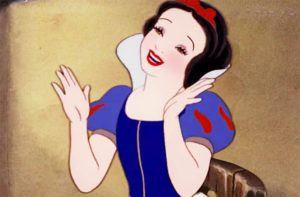 After 79 years and 49 official animated features, Walt Disney – which by this point has transcended the historical personage to become synonymous with a particular standard of entertainment – has proved inescapable for by-now countless generations of children audiences. And while I wouldn’t go so far to say here that Disney has cornered American childhood, I do think it is accurate to observe that the spirit, dedication, and popular artistry of the animation studio’s consistently high quality output across the decades – from Pinocchio (1940) to Sleeping Beauty (1959), One Hundred and One Dalmatians (1961) to Robin Hood (1973), The Rescuers (1977) to The Great Mouse Detective (1986), The Little Mermaid(1989) to The Lion King (1994), and on up until this year’s 3-D animated Zootopia (2016) – has shaped American childhood in ways we have yet to fully understand.
After 79 years and 49 official animated features, Walt Disney – which by this point has transcended the historical personage to become synonymous with a particular standard of entertainment – has proved inescapable for by-now countless generations of children audiences. And while I wouldn’t go so far to say here that Disney has cornered American childhood, I do think it is accurate to observe that the spirit, dedication, and popular artistry of the animation studio’s consistently high quality output across the decades – from Pinocchio (1940) to Sleeping Beauty (1959), One Hundred and One Dalmatians (1961) to Robin Hood (1973), The Rescuers (1977) to The Great Mouse Detective (1986), The Little Mermaid(1989) to The Lion King (1994), and on up until this year’s 3-D animated Zootopia (2016) – has shaped American childhood in ways we have yet to fully understand.
Considering the above-referenced “inescapability”, then, of Disney movies – particularly, how so many kids’ first movies have, in fact, been Disney movies – it is an odd thing to admit that, years later, one has actually missed a few.
As we are all about rectifying great wrongs here at ZekeFilm, we have decided that this month, as a public service, our contributors will here admit to the BIGGEST among all the great Disney movies that somehow passed them by. Will the all-pervasive, oft-referenced-but-never-fully-defined “Disney Magic” still work its wonders on our contributor’s grown-up, first-time reactions; impressionable children no longer? Read on, film fans!
– Justin Mory
Dumbo
(1941, Walt Disney Productions, supervising director Ben Sharpsteen)
by Robert Hornak

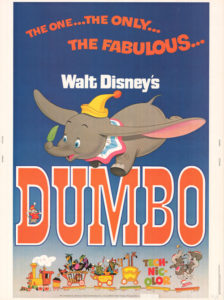 Call me a fan. A 64-minute dollop of sweet, Disney-kissed fantasy that defies ill will. An ugly trunkling fable for misfit kids of all species. Mr. Stork delivers Mrs. Jumbo’s baby a bit late to the circus train, so that his arrival is conspicuous enough to have all eyes on the big reveal: the littlest Jumbo has the massivest ears, a “deformity” that sends Mrs. J.’s so-called friends into mocking outrage mode. They immediately dub him Dumbo, and the moniker sticks. Later, mom is thrown into solitary for defending her baby against some name-calling bullies, and it’s up to surrogate caretaker, Timothy Q. Mouse (the most Looney Tunes-ish Disney character I’ve ever seen, so automatically my new favorite), to guide him through the pitfalls of one’s first days on the planet. Kinda weird that the two end up wasted on champagne – we’re talking about a baby here – especially when it extends into a drunken dream that plays like junior’s first 007 title sequence. Mostly, though, kinda hard not to culture-check the real elephant in the room: an entire sequence wherein Walt and pals go literal with some black crows. But once my knee jerked, it seemed to me that as unavoidable period stereotypes go, these are in the “less sinful” category, since these crows are among the more sympathetic characters in the movie, who show compassion toward our ailing hero, teach him a trade, and, frankly, bring some spirit to a movie that was in danger of slipping off into full-bore sentimentality. Thus I wag a justified finger, and enjoy the movie just the same – hate the sin, love the cinema.
Call me a fan. A 64-minute dollop of sweet, Disney-kissed fantasy that defies ill will. An ugly trunkling fable for misfit kids of all species. Mr. Stork delivers Mrs. Jumbo’s baby a bit late to the circus train, so that his arrival is conspicuous enough to have all eyes on the big reveal: the littlest Jumbo has the massivest ears, a “deformity” that sends Mrs. J.’s so-called friends into mocking outrage mode. They immediately dub him Dumbo, and the moniker sticks. Later, mom is thrown into solitary for defending her baby against some name-calling bullies, and it’s up to surrogate caretaker, Timothy Q. Mouse (the most Looney Tunes-ish Disney character I’ve ever seen, so automatically my new favorite), to guide him through the pitfalls of one’s first days on the planet. Kinda weird that the two end up wasted on champagne – we’re talking about a baby here – especially when it extends into a drunken dream that plays like junior’s first 007 title sequence. Mostly, though, kinda hard not to culture-check the real elephant in the room: an entire sequence wherein Walt and pals go literal with some black crows. But once my knee jerked, it seemed to me that as unavoidable period stereotypes go, these are in the “less sinful” category, since these crows are among the more sympathetic characters in the movie, who show compassion toward our ailing hero, teach him a trade, and, frankly, bring some spirit to a movie that was in danger of slipping off into full-bore sentimentality. Thus I wag a justified finger, and enjoy the movie just the same – hate the sin, love the cinema.
I expected the whole movie to be about the little guy flying, since that’s the focus of all the artwork I’ve ever seen for it. The fact that he doesn’t take off for the first hour of a 64-minute movie at first made me think I’d skipped a reel. But no. So he doesn’t fly much, but when he does he makes it count, darting over the gathered pachydames who mocked him earlier, meting out a little redemptive violence in the form of peanuts shot from his now-turret-like trunk. Finally, faithful T.Q. Mouse teaches Dumbo the value of flaunting whatcha got for a little bit of fame and, I assume, fortune. Once he’s properly empowered, I half-expected Dumbo – silent for the entire movie – to finally belt out into a song, one called Airborne This Way. But all this self-actualization is treated sweetly, and Dumbo’s return to his mother is an unqualified triumph – almost making you forget the other major knee-jerk culture-check, that the world Dumbo is won back into on his own terms is still the cruelly inhumane non-life of an animal in a traveling circus. What he needs is a group of sassy, enlightened tweens to come to his rescue. Dumbo 2, anyone?
The Great Mouse Detective
(1986, Walt Disney Pictures, dir(s). Ron Clements et al.)
by Jim Tudor
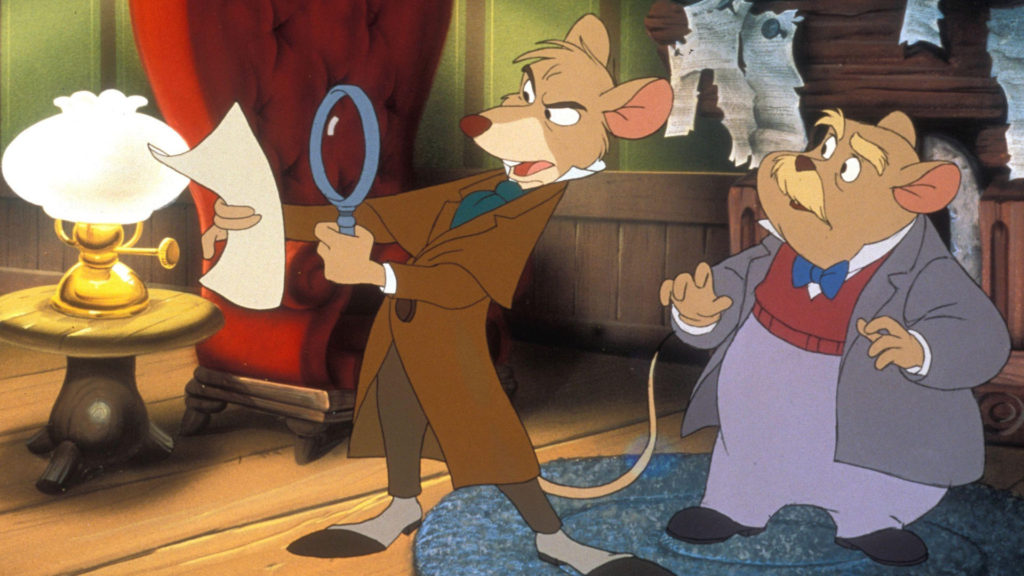
 Disney may not have known much in the 1980s, but if there’s one thing they’ve always known, it’s mice. Although for the “mouse house”, the decade proved to be a notoriously dark one prior to 1989’s sea-changer The Little Mermaid, 1986’s The Great Mouse Detective demonstrates that the company’s animation resurgence may be more rooted in their unfavored Michael Eisner era than many care to admit. The film is an action/comedy about a brilliant if socially awkward rodent ala Sherlock Holmes. (And whom, for good measure, shares residence with him at 221b Baker Street.). A spirited adaptation of Eve Titus’ and Paul Galdone’s children’s books of the same name, the studio found a crackling new mouse. (In this time their universally recognizable flagship character Mickey Mouse was creatively off the table, reduced to an innocuous corporate mascot and wrung dry. Mickey wasn’t allowed to get angry, upset, disheveled, etc).
Disney may not have known much in the 1980s, but if there’s one thing they’ve always known, it’s mice. Although for the “mouse house”, the decade proved to be a notoriously dark one prior to 1989’s sea-changer The Little Mermaid, 1986’s The Great Mouse Detective demonstrates that the company’s animation resurgence may be more rooted in their unfavored Michael Eisner era than many care to admit. The film is an action/comedy about a brilliant if socially awkward rodent ala Sherlock Holmes. (And whom, for good measure, shares residence with him at 221b Baker Street.). A spirited adaptation of Eve Titus’ and Paul Galdone’s children’s books of the same name, the studio found a crackling new mouse. (In this time their universally recognizable flagship character Mickey Mouse was creatively off the table, reduced to an innocuous corporate mascot and wrung dry. Mickey wasn’t allowed to get angry, upset, disheveled, etc).
Basil, the titular mouse detective, joins the array of other animated mid-1980s mice – Fievel, Danger Mouse, and company. Although TGMD lives up to its title as a snappy adventure film, the second and third tier mustiness of Disney as an entity can’t help but be evident. Although terrific, it’s undeniably noticeable how much of the cast and musical talent is made up of past-their-primers: Barrie Ingham as the voice of Basil, voice actor Val Bettin as his faithful Watson-like assistant Dr. Dawson, and most notably, Vincent Price as the villainous Ratigan. Musically, the legendary Henry Mancini (of Pink Panther fame) handles the score while Melissa Manchester contributes a mildly risqué cabaret number. All are great, even appropriate amid their then-prevailing grayness. Price’s performance is particularly noteworthy since he A) sings, and B) affects a voice other than his own, above and beyond the effort he was likely hired to put forth. This is no mere glorified “Thriller” reading.
Technically, TGMD is marred slightly by its being part of Disney’s “Dark era”, a period that arose from it’s cost-cutting “Xerox era” which eliminated “inbetweener” artists, resulting in a rougher, sketchier look to the films from the late 1960s until the later 1980s. Basically, they were literally xeroxing the animators rough sketches directly onto clear cels to be painted, eliminating the long-standing middle job of translating the sketches onto cels with a clean, defined black line. This technique arose amid 1961’s 101 Dalmations in an effort to lighten the workload of dealing with so many dogs onscreen. Much to aging Walt’s chagrin, it stuck.
And, like so much of animation at the time, there’s an atmospheric murkiness about TGMD. Yet, this being Victorian London, that vibe is entirely proper. Most notably perhaps, TGMD bears the distinction of being the first major animated feature to utilize computer animation. It’s just one sequence, but a keeper: The conventionally rendered characters have a climactic chase through the crushing cogs of Big Ben. It’s one of several high-stakes action sequences that hold up today.
By opening a book to the past, Disney as an entity honored the visionary legacy of Uncle Walt, pushing forward in terms of the technical and tempo while also telling a thrilling and fun tale. Today, TGMD‘s mark is evident, even if is that of a graying, partially forgotten mouse.
Pocahontas
(1995, Walt Disney Pictures, dir(s). Mike Gabriel, Eric Goldberg)
by David Strugar

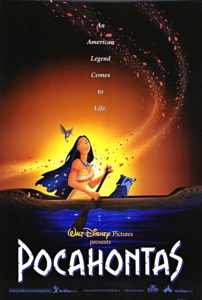 Pocahontas debuted just as I was aging out of going to Disney movies on the regular. Granted, I hit that age a little older than most, and the phase only lasted a short while. I am a Disney geek at heart, and that’s never changing.
Pocahontas debuted just as I was aging out of going to Disney movies on the regular. Granted, I hit that age a little older than most, and the phase only lasted a short while. I am a Disney geek at heart, and that’s never changing.
But Pocahontas also had a lot of “New-Agey” stuff about every rock and tree having a spirit and a name, and that was problematic for me at that point in my spiritual development. Not that I’m a pantheist now or anything, but a song in a Disney movie isn’t going to shake my faith. Finally catching up on this movie 20 years after it came out, I also felt the sting of other problematic elements, and I’m not completely sure how I feel about it all.
The titular character herself certainly stands out as one of the most independent heroines Disney ever produced. She remains active in the story throughout—even Belle and Ariel fade to the background by the end while their princes finish the climactic battle—and she decides not to join her One True Love at the end. The songs don’t click for me like the classic Ashman-Menken numbers from the previous films, but Pocahontas’ simple lyric “You think you own whatever land you land on…You think the only people who are people, Are the people who look and think like you,” while slightly on the nose, is appropriately devastating in its judgment.
But John Smith is terribly uninteresting as a hero, and Governor Ratcliffe is equally flat as a compelling villain. The animal characters inject some fun into the show, but overall the film is trying very hard to be earnest and respectful, and Meeko the raccoon’s antics feel like a Looney Tunes cartoon playing in the middle of a PBS special. Naturally, the filmmakers took liberties with historical accuracy, most notable Pocahontas’ age—but really, you can’t blame them for not making a movie about an 11-year-old having a romance with a grown man.
And the animation, I have to say, is suitably lush and vivid. Simply watching it was almost a tactile experience.
It’s just that the movie feels like it’s trying to have its cake and eat it, too, by respectfully portraying a real historical character and an historically oppressed people in a fantasy story meant to entertain an all-ages audience—all drawn, written, and produced by a group of mostly white guys. While a few Native American consultants were brought on for the production, very few of them were satisfied with the end result. One wonders if the studio couldn’t have just found a different story to tell rather than tackle an obviously dicey tale, or at least let the people to whom the story’s main character belongs have a voice in telling it.
The Princess and the Frog
(2009, Walt Disney Pictures, dir(s). Ron Clements, John Musker)
by Sharon Autenrieth
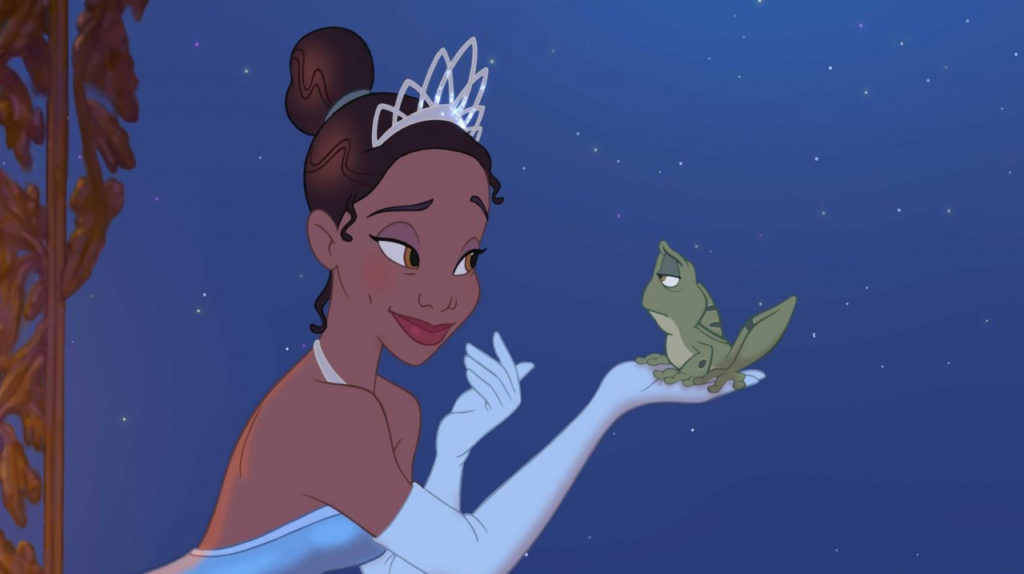
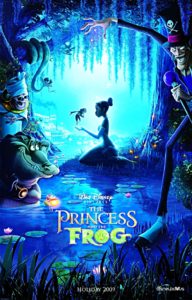 The Princess and the Frog’s unique claim to fame was that it introduced the first (and so far, only) black Disney princess. That’s not a small thing, and I cheered that milestone along with my children – although I somehow missed actually watching the movie with them. My question as I approached the movie several years later was whether it would have much to offer besides that important expansion of what a Disney princess can look like.
The Princess and the Frog’s unique claim to fame was that it introduced the first (and so far, only) black Disney princess. That’s not a small thing, and I cheered that milestone along with my children – although I somehow missed actually watching the movie with them. My question as I approached the movie several years later was whether it would have much to offer besides that important expansion of what a Disney princess can look like.
And the verdict is…The Princess and the Frog is pretty good! It’s not a masterpiece: we’re not talking about Beauty and the Beast here – but that’s actually not a bad comparison. With The Princess and the Frog Disney returned to the hand drawn animation, and as in Beauty and the Beast this works especially well with light. Whether it’s a procession or fireflies gliding through the Bayou or a brightly lit Mardi Gras parade, the animation glows beautifully. Also as in Beauty and the Beast, this princess is a working class girl with a sharp mind. Remember Belle, consumed by her love for books? Tiana (Anika Noni Rose) is likewise consumed, although in her case it’s by a dream of owning her own restaurant. She is independent and hardworking, determined to bring to completion the vision she and her father shared before he died. In other words, like Belle, Tiana is not silly, or spoiled, or isolated from the world. There is a silly, spoiled princess in this movie – Charlotte La Bouff (Jennifer Cody), daughter of a “Big Daddy” La Bouff (John Goodman). “Big Daddy” is big money in New Orleans, and “Lottie” is giggly, pampered, romance-obsessed. But Disney does something a bit unexpected in contrasting Lottie – a blonde, exaggerated throwback to earlier Disney princesses – with Tiana. Lottie is not an antagonist, but Tiana’s best friend. It’s perhaps unlikely in 1920s New Orleans that a wealthy white women and a black woman (whose mother serves as Lottie’s seamstress) would be so close, but…this is Disney. Giving us a black princess doesn’t mean that they were going to realistically depict race relations in American history, and most parents not only understand but are grateful. There’s time enough to give our children the bad news.
As for the inevitable love interest, Prince Naveen (Bruno Campos), he’s vaguely foreign and of ambiguous ethnicity. He had to be: Lottie wants to marry him, so he mustn’t be black (because remember, this is 1920s New Orleans). But he will wind up as Tiana’s love interest, so he mustn’t be a Prince Charming shade of white, either. In fact, Disney came under criticism for the lightness of Prince Naveen’s skin – considerably lighter than Tiana’s. It’s more interesting to me that he is, essentially, the male counterpart to Lottie. A pampered ne’er do well, he has a lot of growing up to do before he will be worthy of a young woman like Tiana. It’s not much of a spoiler to say that both Naveen and Tiana spend a signficant part of the movie as frogs, and this is just the trial that Naveen needs in order to change his ways.
The Princess and the Frog uses the visual richness of New Orleans and the Louisiana bayou to good effect, and has some vibrant Randy Newman songs to boot. It’s depiction of voodoo is problematic, however. The villain of the movie is a voodoo practioner named Facilier (Keith David) but there’s also a good practioner, too – Mama Odie (Jenifer Lewis). The film seems to be drawing a distinction between the power of voodoo used for evil or for good; but while Facilier’s power is certainly on display, Mama Odie seems to mostly just provide advice. She does, however, get to sing the best song (“Dig a Little Deeper”), so she’s got that going for her.
Finally, I have to mention the Cajun firefly, Ray (Jim Cummings), and his love for a star named Evangeline. This subplot, first treated as a joke, turns into a moving parable for the biblical notion that “love is stronger than death”.
The Princess and the Frog is not an unforgettably great Disney film, but it’s a good, solid entry among the hand drawn Disney films – and it’s easy too root for Tiana; a smart, hardworking, no-nonsense young woman (even when she’s a frog).
Frozen
(2013, Walt Disney Pictures, dir(s). Chris Buck & Jennifer Lee)
by Justin Mory

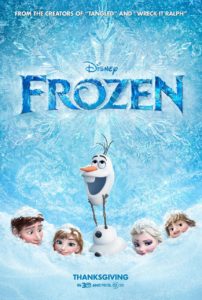 My work at a used bookstore currently involves sorting through heaping mounds of kids’ books and somehow cramming them onto bookshelves, dodging between shopping parents and their children all the while. One particular bane of this activity is organizing two shelves marked “Disney” and, more particularly, an extremely popular book, journals, accessories, and catch-all ‘miscellaneous’ line called “Disney Princess”.
My work at a used bookstore currently involves sorting through heaping mounds of kids’ books and somehow cramming them onto bookshelves, dodging between shopping parents and their children all the while. One particular bane of this activity is organizing two shelves marked “Disney” and, more particularly, an extremely popular book, journals, accessories, and catch-all ‘miscellaneous’ line called “Disney Princess”.
Personally, I don’t get it. To me, the various princesses from Disney movies past – beginning with Snow White, Cinderella, and Sleeping Beauty – were always the least compelling figures from their self-titled movies and what really brought the stories to life were the wonderful supporting characters: your Jiminy Crickets, Timothy Mouses, Fairy Godmothers, and – of course – the Docgrumpyhappysleepybashfulsneezydopeys from the introduction.
Which is why I approached this month’s Admission of Frozen with some trepidation. Being aware of what, within 3 years, has become its own cottage industry of sorts – the film and its characters currently occupy their own entire display wall in my store’s kids’ section – there was nothing to suggest in Frozen‘s relentless over-marketing that I would in any way want to submit myself to a story with not one, but two Disney “princesses”.
Very loosely based on a fairy tale by Hans Christian Andersen, the crux of the story indeed lies in the sibling rivalry between princesses Anna and Elsa, who have been separated since childhood due to Elsa’s magical abilities with snow and ice. Unlike many of their predecessors, though, the princesses here are three-dimensional (both animation and character-wise) and the film itself has imagination, humor, and tuneful songs to spare – along with an unflappable living snowman named Olaf in the firm tradition of my beloved Disney side characters of old – BUT, for whatever reason, while watching I was unable to erase the specter of having shelved an entire cart-full of Frozen books the very day before…
With Tangled (2010), Wreck-It Ralph (2012), and most recently Zootopia (2016), Disney has undergone a revival the past few years to match the current gold standard of the animation industry, Pixar, and many would say their most recent efforts have actually exceeded the entertainment and quality factors of their in-house rival. Frozen is certainly no exception, and I can in no way fault any aspect of its production for leaving me a little, well, cold.
So, I’m gonna declare a “do-over” on this decidedly prejudiced first-time viewing and watch it again at some point when I’m no longer toiling over *insert mild expletive here* kids’ books.

